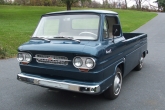
Hillman Imp - Poor Man's Porsche, English Style...
This is one of the many articles published in the monthly NJACE Fanbelt newsletter.

Creative automotive design flourished in the late 1950s and early 1960s,
especially in the U.K. Most auto enthusiasts are aware of the
transverse-engine front wheel drive Austin Mini, designed by Alec Issigonis. The Mini's basic power train layout, so brilliant because of its compact
packaging, continues to serve as the blueprint for almost every passenger
car in production today. However, the Mini was not the only small British
sedan worthy of our interest. The U.K. also produced its own
"Poor Man's Porsche".
At the same time that Chevrolet was developing prototypes for the
Corvair, the Rootes Group in England was designing a smaller but similar
rear engine economy car, the Hillman Imp. Development of the Imp began in
1955, but production did not start until 1963, three years after the Corvair
was introduced. The Imp remained in the Rootes lineup until 1976.
Head-on, the Imp looks like a miniature early-series Corvair. The
resemblance is more than coincidental.
While Rootes stylists were borrowing
contours from the Corvair body, Rootes engineers were test-driving Corvairs,
looking for technical solutions to rear engine design problems. Unlike their
counterparts in the styling department, the engineers didn't copy the
Corvair so readily. After crashing one 'Vair rather severely at the test
track, Rootes rejected swing axles and adopted a fully articulated
multi-link rear suspension for the Imp. And, to minimize rearward weight
bias, the Rootes engineering staff insisted on a lightweight all-aluminum
engine.
And what an engine it was! For the basic layout, Rootes engineers called
upon Coventry Climax, one of the most renowned engine designers in the
world. Coventry Climax engines powered some of that period's most successful
Formula 1 cars, including the Lotus 18 and the Cooper T51. Coventry Climax
was eager to capitalize on its racing success and sold Rootes the production
rights to a state of the art overhead cam 750 cc four cylinder engine. Rootes
proceeded to modify the design to make it suitable for the Imp by opening it
up to 875 cc, laying it over on a 45 degree angle, increasing the
compression ratio to 10:1, and die-casting the block and head in aluminum.
One of the problems of an aluminum block is that, without steel liners,
cylinder bores are subject to premature wear. However, the process of
pressing steel cylinder liners into an aluminum block represents a
considerable manufacturing expense. Like the engineers who developed the
Corvair engine, Rootes almost specified a hard high-silicon alloy to negate
the need for liners. However, again like their counterparts at GM, Rootes
found that it could not master the technique of machining this unproven
material.
Rather than give up, Rootes chose another alternative, opting for an
aluminum block with iron liners cast in-situ, just like Buick's 1961
aluminum V-8. The quest for weight reduction paid off. The finished engine
weighed just 170 pounds, "including accessories."
The little Climax engine was water-cooled, so the engineers positioned
the radiator alongside the engine behind the rear seat. This solution,
common to the Fiat 600, Simca 1000, Renault R8, and a number of other
European rear engine cars, compromised cooling efficiency but avoided the
need to mount the radiator in the front luggage compartment. This
simplified the plumbing and provided a modest boost in luggage space.
Like most innovative cars, Imps gained a reputation for teething
problems. Rootes worked hard to correct these problems, but most consumers
in the English economy car market took the conservative approach and
selected Brand X instead. Over thirteen years of production, about
500,000 Imps were sold.


Sports car enthusiasts, however, recognized that the Imp offered great
driving fun at reasonable cost. The Coventry Climax engine was smooth and
could be revved with confidence up to 7,000 rpm. English car magazines raved
about the Imp's excellent handling, which apparently was as good as the
Austin Mini's. All over the Isles, enthusiasts entered Imps in club events
for many years. Two specialty manufacturers, Ginetta and Clan,
produced hand-built sports cars based on Imp components, quite similar to
the Corvair-based Fitch Phoenix in concept.
If you would like to read more about the Hillman Imp, there are a number
of web-sites that will satisfy your interest, including "The Imp Site",
which through the courtesy of Franka Steenhuis, served as the source for
much of the information in this article.

Corvair - The most innovative cars and trucks ever produced in America!




Click HERE to go back to the NJACE Home Page. Edited by redbat01@verizon.net on 10/23/2023